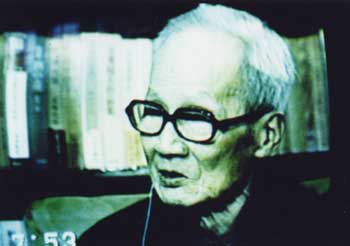
| Return |
|
• May 29 Mr. Koichiro Tomita , a former Tokyo Astronomical Observatory staff member, inquired about a telescope owned by the Yamanouchi Family (a great feudal lord) in Tosa (Kochi). I sent him a number of photographs of the telescope. Photo 1 below is one of them I sent to Mr. Tomita and shows Mr. keiichiro Okamura, a researcher on astronomical history of Tosa, and myself. The telescope seems to have been acquired about 200 years ago during the days of Yodo Yamanouchi, the last daimyo (feudal lord) of Tosa. There are also many armillary spheres among astronomical instruments preserved by the family. This telescope was made in Germany (by Schneider Optics) . Its aperture is 80mm with an f/15 focal ratio equipped with three eyepieces and a solar filter for astronomical use. It also includes a correct-image terrestrial eyepiece. In 1987 Dr. Marsden saw this telescope. I wonder who acquired this telescope for what purpose. Did the acquirer observe astronomical objects with this telescope? Is that person Yodo himself? Or is it Ryoma Sakamoto, who was always ahead of times with his foresight? Did Ryoma's thinking, which was much more global against the backdrop of the isolationist Japan, rise from the knowledge of the vastness of the universe, the insight he had acquired by observing the great universe? Or is this conclusion too hasty? Ryoma Sakamoto was born on November 15, 1835 and given the name Ryoma (galloping horse) , when Halley's Comet was blazing overhead. The comet was compared to a soaring dragon and galloping horse. In March 1986 I saw Halley's Comet through this telescope that Ryoma may have used. That beauty of the comet was unforgettable. |
 Photograph 1 The telescope owned by the Yamanouchi Family and Mr. Keiichiro Okamura  Photograph 2 Dr. Marsden (left) and myself in front of Ryoma's bronze statue. |
|
• May 20 I arrived at the observatory late at night. I looked for the firefly glowing in the grass which I had seen the previous night, but could not see any sign of it. Only starlight is seen in the heavens. I remembered Mr. Hoei Nojiri's poem: Constellations of fireflies glowing in the grass beautiful greenish blue.Photo 1 is a portrait of Mr. Hoei Nojiri. This photo was taken when he appeared on NHK TV about 30 years ago. On the program he said he had crated the "Orion Memorial Cemetery. The Orion Memorial Cemetery...It sounds beautiful, doesn't it? Mr. Nojiri, I am sure, is sleeping in peace in this Memorial Cemetery. Summer is just around the corner. The Milky Way was especially beautiful projected clearly against the southern sky. In the morning twilight I searched the eastern sky. M32 was barely visible near M31, though it was not seen yesterday morning due to its low altitude location. There was a big excitement on the morning of May 1, about 35 years ago, when five people discovered the same comet (Comet Tago-Honda-Yamamoto) around the same time. The photograph shows M31. C/1968H1(Tago-Honda-Yamamoto) was discovered near M31 at 6th magnitude. |
 Photo 1 Mr. Hoei Nojiri  Photo 2 Re-emerging M31 At 4 am on May 1, 2003 2-minute exposure with ε210 |
Copyright (C) 2003 Tsutomu Seki.